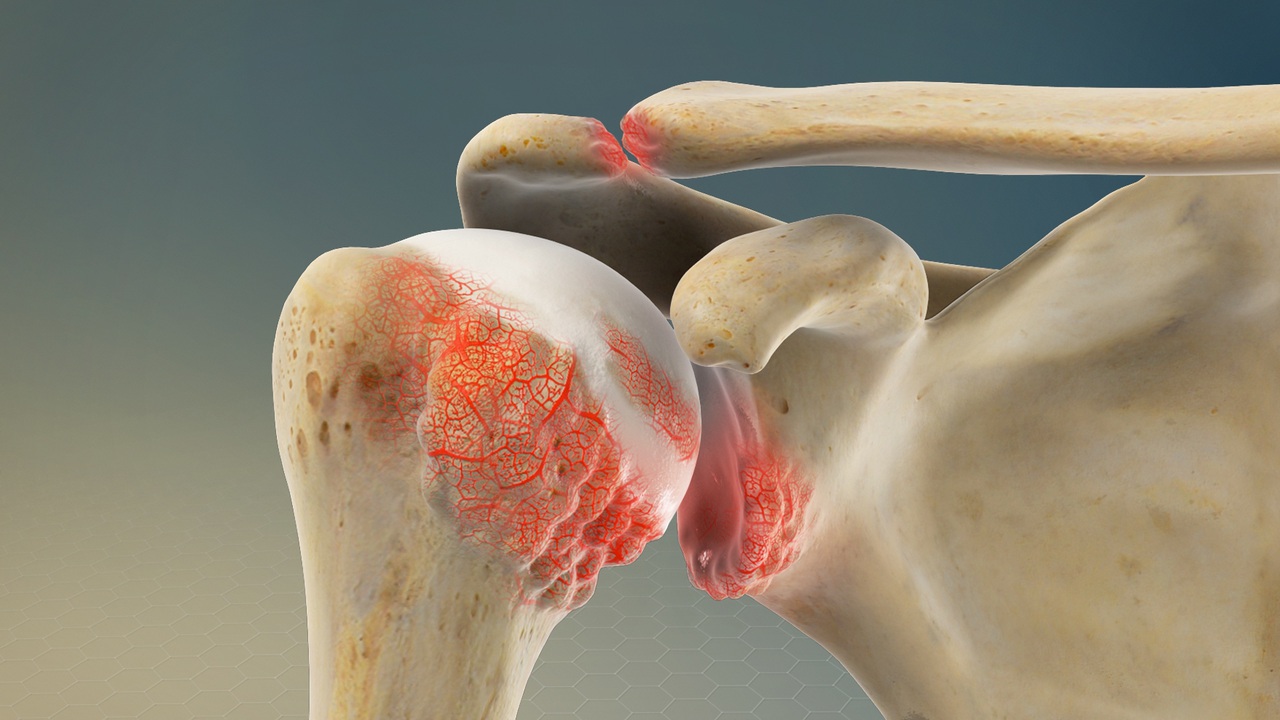- Home
- AC joint Arthritis Treatments
AC joint Arthritis Treatments
What is shoulder arthritis?
Shoulder arthritis is damage to the cartilage inside the shoulder joint. The shoulder has two joints. Shoulder arthritis commonly refers to the bigger ball-and-socket joint named the glenohumeral joint after the bones it connects (glenoid and humerus). The cartilage covers both the ball (the humeral head) and the socket (the glenoid).When the cartilage in the shoulder begins to break down on the surface and eventually in the deeper layers, it’s called shoulder arthritis. The second joint in the shoulder, the acromioclavicular or AC joint, can also develop arthritis known as AC joint arthritis.

How does shoulder arthritis develop?
Shoulder arthritis usually results from gradual wear and tear of the cartilage. Cartilage is present in every joint in the body; it covers the surface of the bones inside the joints similar to Teflon on a ball bearing. Cartilage is a living tissue 2 millimeters to 3 millimeters thick — about the thickness of one or two layers of cardboard. This makes the contact between bones softer. If the cartilage is intact, it can take multiple rotations with no wear of the surface because it’s smooth.
Shoulder arthritis typically develops in stages. First the cartilage gets soft (A), then it develops cracks in the surface (B), then it begins to “fibrillate” (deteriorate and flake) (C), and finally it wears away to expose the surface of the bone (D). As a result, it loses its ability to act as a smooth, gliding surface. The cartilage doesn’t wear away all at once over the entire surface of the bone in a joint. Instead, it wears at different rates in different parts. So if you consider the surface of a ball bearing that was covered with Teflon, this type of wear would be as if the Teflon had pits and the surface would now be irregular (see the image below).
BOOK AN APPOINTMENT
You Don't Have To Live With Pain
Dr. Rahul Bade is a specialist Knee & Shoulder Surgeon.
Once the surface becomes irregular, the cartilage may undergo further damage. It may begin to thin out, eventually leading to the bones of the shoulder rubbing against each other (stage four cartilage loss). Many people think that arthritis is bone-on-bone traction in the joint, but in reality arthritis is the process that can lead to the bone-on-bone traction.
It is impossible to tell how fast shoulder arthritis will get worse. Every person’s shoulder joint has different degrees of damage to the cartilage. Typically, when certain activities produce pain, it means that the cartilage is experiencing stress. Generally, the more painful the activity, the more likely it is to damage the cartilage and the shoulder joint further.
Shoulder Arthritis Treatment
Injections for Shoulder Arthritis
There are currently two types of injections that can provide pain relief for shoulder arthritis. The first type is cortisone shots. Typically, cortisone is mixed with a numbing agent that provides immediate pain relief and helps your doctor know if the injection is in the right place. Once the numbing medicine wears off, the joint may be sore until the cortisone kicks in. It’s important to ice the shoulder for a day or so after the shot.
Cortisone shots don’t damage the shoulder, but most surgeons limit them to no more than a few a year in most cases of arthritis. Cortisone shots may increase the risk of infection if you undergo a total shoulder replacement soon after the shot. If you are considering the surgery, consider avoiding cortisone shots a few months prior.
The other medicine that can help with shoulder arthritis is synthetically manufactured hyaluronic acid. It’s a naturally occurring lubricant in the human body. This liquid substance has been injected into arthritic knees for many years. This injection sometimes helps with the pain for up to two years, but it is unusual for it to take all the pain away for an extended period of time.
The current recommendation is not to have shoulder replacement surgery within three months of having a cortisone shot in the shoulder. If you are considering surgery, it is best to avoid cortisone shots until you have discussed it with your doctor.
Shoulder Surgery
When the nonsurgical treatments don’t work any longer, you may need surgery. Surgical options depend on your age and the degree of arthritis.
Arthroscopic Shoulder Debridement
This minimally invasive procedure uses a small camera (an arthroscope) and surgical tools inserted through small incisions to “clean out” (debride) the shoulder joint. It is recommended for patients with lower grades of arthritis and is typically not recommended when there is bone-on-bone traction.
If you have some cartilage left in the joint, sometimes debridement can provide pain relief. No bone spurs are removed during this procedure, as the spurs are the result of arthritis and not the cause. This operation is considered a success if it relieves pain for 12 to 24 months. Although in some cases the pain relief may last longer, this operation is typically not a permanent solution for shoulder arthritis as it does not change the presence of the disease.



